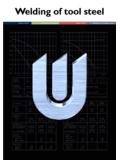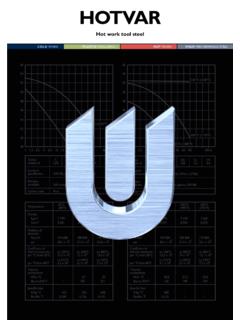Transcription of Grinding of tool steel - Bohler Uddeholm
1 Grinding of tool steelGrindingof tool Steel2 ContentsIntroduction .. 3 Grinding wheel design .. 3 How the Grinding wheel works .. 5 The Grinding machine .. 7 Grinding fluid .. 7 The tool steel .. 8 Recommendations for Grinding ofUddeholm tool steels .. 11 Cutting speed and feed .. 12 Grinding wheel dressing .. 13 Recommended Grinding wheels .. 14 This information is based on our present state of knowledge and isintended to provide general notes on our products and their should not therefore be construed as a warranty of specificproperties of the products described or a warranty for fitness for aparticular tool Steel31.
2 Aluminium oxide is the abrasive most com-monly used for Grinding steel , and is available inseveral variants. It can be alloyed with otheroxides, of which the most common is titaniumoxide. The table below shows how the characteris-tics of aluminium oxide abrasive can be varied byalloying , the colour of a Grinding wheeldoes not always necessarily indicate the type ofabrasive used in it, due to the fact that some grind-ing wheel manufacturers colour their abrasivesand recent years, a new type of aluminium oxidehas been developed, having a fine crystalline struc-ture, which means that the grains retain theirsharpness better.
3 However, its use requires highergrinding pressure. A typical application for it isgrinding tool steels in rigid Grinding example of this abrasive is Norton SG (SeededGel).ABRASIVEIt is important that the abrasive fulfils require-ments in respect of: Hardness Sharpness Thermal resistance Chemical , the following four main groups ofabrasives (all synthetic) are used, fulfilling theabove requirements to greater or lesser extents:1. Aluminium oxide designation:A (SG)2. Silicon carbide,,C3. Boron nitride,,B4. Diamond,,SDAbrasives have different application areas,depending on their particular characteristics, asshown partially in the table :IntroductionThe high alloy content of tool steels means thatsuch steels are often more difficult to grind thanconventional structural order to achieve successful results whengrinding tool steels, it is necessary to choose thegrinding wheel with care.
4 In turn, choosing theright Grinding wheel and Grinding data requires anunderstanding of how a Grinding wheel brochure provides a quite detailed de-scription of the make-up of the wheel, of how itworks when Grinding and of the parameters thatdetermine the final result. It also includes recom-mendations for Grinding wheels for use with Udde-holm tool steels. A 46 H VAbrasiveGrain sizeGradeBinderHarderTougherBond bridgesAbrasivegrainAir poresHardnessThermal durabilityAbrasiveKnoopin airkp/mm2 CAluminium oxide21002000 Silicon carbide25001200 Boron nitride47001400 Diamond7000 650 AbrasiveColourPropertiesNormal corundumBrown, greyMixed corundumYellowbrownRed aluminaRedWhite aluminaWhiteFigure 1.
5 The arrangement and proportions of abrasivegrains, air pores and bond bridges (made up of binder)determine Grinding wheel special Grinding wheels, such asmetallically bonded diamond wheels, contain noair is the composition and variation of the abovecomponents that determines the characteristic of agrinding wheel. An identification system, whichhas now been ratified as an international standardby ISO, indicates the composition of grindingwheels. The identification consists of numeralsand letters in a particular sequence, defining theabrasive, grain size, grade and wheeldesignIn principle, a Grinding wheel consists of the fol-lowing components: Abrasive Binder Air tool Steel42.
6 Silicon carbide is an abrasive that is used pri-marily for Grinding cast iron and austenitic stain-less steels, although it can also be used for hard-ened tool steels. It occurs in two main variants:the black silicon carbide and a somewhat hardergreen variant, which is more brittle than the Boron nitride is produced in approximatelythe same way as synthetic diamond, and is an ab-rasive that is used primarily for Grinding hardenedhigh-carbide tool steels and high-speed steels. Adrawback of boron nitride is its high price almosttwice that of synthetic Diamond is seldom used, despite its high hard-ness, for Grinding tool steels as a result of its lowthermal resistance.
7 Diamond is used primarily forgrinding cemented carbide and ceramic grade of a wheel is indicated by a letter, indi-cating the hardness in alphabetical order:E = very soft compositionZ = very hard tool steels, the most commonly encoun-tered compositions are within the hardness rangeG- K. Indication of the grade is sometimesfollowed by a numeral, which indicates the spreadof the abrasive particles in the WHEEL BINDERSThe following binders are used to bind the grainsin a Grinding wheel: Vitrified designation:V Resinoid,,B Rubber ,,R Metal,,MVitrified Grinding wheels are those most com-monly used for Grinding tool is used as a binder in Grinding wheelsintended for high peripheral speeds, such as cer-tain boron nitride wheels are used for high specificgrinding pressures, such as for control wheels incentreless binders are used for diamond and cer-tain boron nitride wheels.
8 Such wheels can with-stand very high peripheral 1. The difference between a boron nitride wheeland a conventional Grinding a result of the high price of boron nitride, wheelsmade from it consist of a thin layer of abrasive appliedto a central hub, usually of GRAIN SIZEThe grain size of the abrasive is an important factorin selecting the correct Grinding wheel. Grain sizesare classified in accordance with an internationalmesh size in mesh/inch, ranging from 8 (coarse)to 1200 (super-fine).Grain sizes for Grinding tool steels are gen-erally in the range 24- 100 mesh.
9 Coarse grainsizes are used for rapid rate of removal, whengrinding large workpieces, Grinding softer materi-als or when the contact surface of the grindingwheel is large. Fine grain sizes are used to producehigh surface finish, when Grinding hard materialsor when the contact surface of the Grinding wheelis surface smoothness of the ground partdepends not only on the grain size of the grindingwheel. The sharpness of the wheel, the bondingmaterial used and the hardness of the wheel alsoplay a considerable part in determining the surfacefinish the case of diamond and boron nitridegrinding wheels, European Grinding wheel manu-facturers indicate grain size by the diameter of theabrasive grains in microns, while American andJapanese manufacturers indicate it in mesh WHEEL GRADEThe grade of a Grinding wheel refers to its hard-ness, how securely the abrasive grains are heldby the binder.
10 It does not, therefore, depend on thehardness of the abrasive used in the grade of a Grinding wheel is determinedprimarily by the quantity of binder used in thewheel. A higher proportion of binder reduces theamount of air pores and produces a harder tool Steel5 Figure 3. A large chip size results in a rougher surfacefinish on the chipSmall chipFigure 2. Chip formation when Grinding (highlyschematic). Cutting angles are generally surfaceRough surfaceGRINDING FORCESThe Grinding forces that act on each individualgrain of abrasive are referred to as specificforces.







